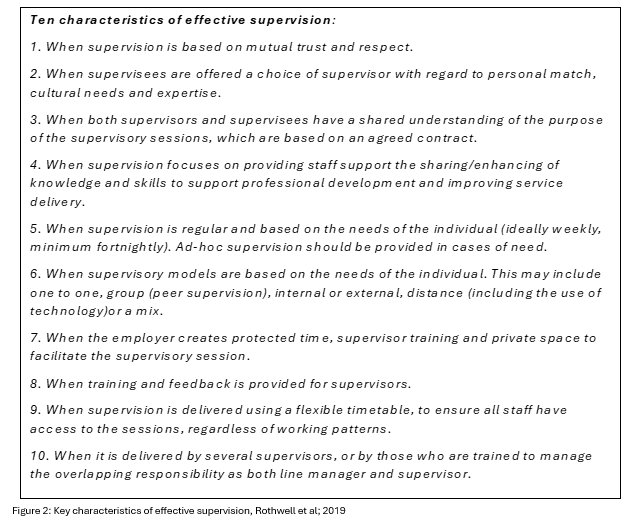Access to good quality supervision is essential to enhance an individuals practice and support lifelong learning but how do we know what good supervision looks like? The HCPC commissioned Newcastle University to undertake a literature review1 to answer this question by establishing what makes supervision effective. This review identified 10 characteristics;

Figure 2: Key characteristics of effective supervision, Rothwell et al; 2019
In establishing or reviewing the supervision offered within your service, these 10 key characteristics should be considered and embedded where practicable.
Other considerations relate to the environment and logistics of the supervision session and include:
Environment – A neutral, safe space that facilitates confidentiality is key to building an open and trusting relationship between supervisor and supervisee. Ideally this will be in a mutually convenient location, away from the usual workplace to minimise disturbance. For those working in different locations, this should be negotiated and clarified within the supervision agreement.
Time – Both parties need to respect and keep to the allocated time given for the session, particularly where people have different start and finish times to their day. These should only run over if absolutely necessary and by both parties’ agreement. Time to undertake informal supervision can be a particular challenge where this may not be held equally by both parties.
Confidentiality – All content discussed in sessions must be kept confidential. The only exceptions are where there are concerns about a practitioner’s conduct, competence, physical or mental health. Where appropriate, permission should be sought to share content with others outside of the supervision partnership, see If concerns are raised during supervision.
Documentation – It is good practice to document supervision sessions. It should be written into the supervision agreement who is responsible for this and how it will be stored. All records must be considered confidential and stored in an appropriate way to ensure security. Both parties need to be clear when the records could be requested and for what purpose. Templates for supervision documentation can be found in the Appendix of this document.
Monitoring and evaluation – The supervision activity should be monitored and evaluated on a regular basis to ensure it continues to meet service need and is addressing the ‘three functions’. As individual practitioners develop, their supervision needs will change, and this may necessitate a different supervisor or amendments to the supervision agreement. Since the quality of supervision activities can influence effectiveness, ongoing monitoring and evaluating ensures there is continued benefit to individual practitioners, service users and the organisation.
There are specific questionnaires, such as the Manchester Clinical Supervision Scale2 developed to measure the efficacy of supervision from the perspective of the supervisor but arrangements for how supervision activities are monitored and evaluated to provide assurance of efficiency should be agreed locally.
References
1. https://www.hcpc-uk.org/resources/reports/2019/effective-clinical-and-peer-supervision-report/
2. https://whitewinstanley.com/mcss26/

